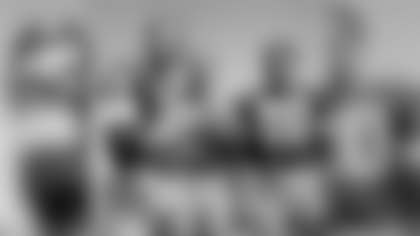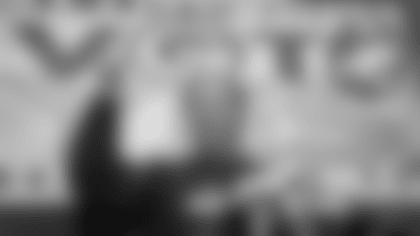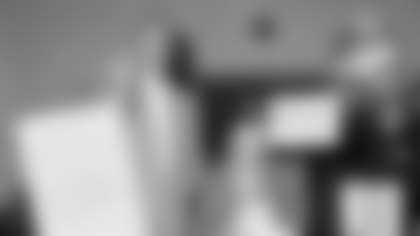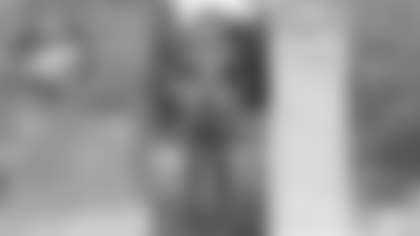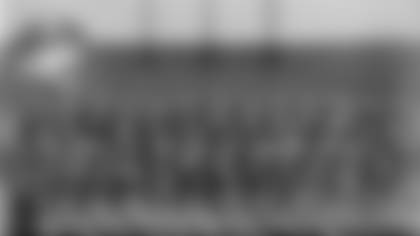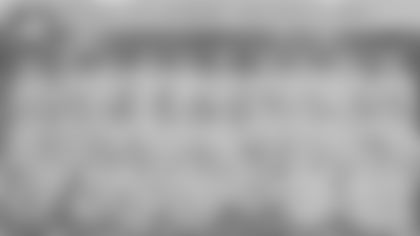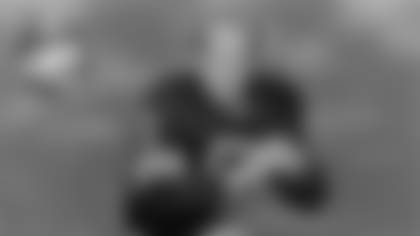Kelly from Kaneohe, Hawaii
Is it true when the NFL was coming together, some people wanted to leave Green Bay out and it was the Bears that stood up and demanded both teams get invited?
No.
The American Professional Football Association was formed in 1920 and the Decatur Staleys were one of its charter members. Two years later, the APFA became the National Football League and the Staleys became the Chicago Bears. In between, Green Bay was admitted to the APFA as the league's membership jumped from 14 to 21 in 1921.
To clarify, the Packers are a year older than the Bears because they started as an independent, semipro team in 1919. That's why this is the Packers' 100th season, but only their 98th in the NFL. The NFL is starting its 99th season and so are the Bears.
In 1920, Decatur had a population of nearly 44,000, roughly 13,000 more than Green Bay. A.E. Staley's starch-making company sponsored the Staleys and George Halas ran the team. A year later, the Staleys played all but one game in Chicago under the name, "The Staley Football Club."
Early that season, Staley instructed Halas to move his base of operation to Chicago, advising him that for a pro football team to survive it needed to be located in a big city. Presumably, Halas had figured that out for himself, as well, and was skeptical about Green Bay's future when it was granted a franchise on Aug. 27, 1921.
From there, the story took a sharp turn when Green Bay was kicked out of the league following that season for using three University of Notre Dame players under assumed names – all had college eligibility remaining – in a non-league game, played in Milwaukee on Dec. 4, against the Racine Legion. At a time when many viewed pro football as an evil threat to the college game, the incident erupted into a national scandal.
The meeting where the Packers were given the boot after just one season was held Jan. 28, 1922, in Canton, Ohio.
More than 60 years later, Larry Names published the first of four books on the history of the Packers and devoted several pages to the scandal, most of which was fanciful nonsense he simply concocted without evidence.
Names wrote that the Packers used the ineligible players in a game against the Staleys (soon to be Bears), credited the Chicago Tribune with first breaking the news, and, as unthinkable as it sounds, claimed Halas was the author of not only the Tribune's initial story but all the articles written about the Staleys in every Chicago paper that season. In summary, Names concluded it was Halas who led the charge to kick the Packers out of the league while he was given a new franchise "without hesitation" at the same meeting.
It's all pure poppycock. Worse, other authors and writers of Packers history have shamelessly repeated it over the years, trying to pass it off as serious research.
Here's the real backdrop.
The Racine Journal-News broke the story the day after the game and correctly identified two of the three Notre Dame players. "Green Bay has several Notre Dame men from this year's lineup with her," the Journal-News noted in its Dec. 5 game story. Racine also used one Notre Dame player, but he was a senior.
What did the Chicago Tribune write about the game? Nothing. Its Monday edition included a five-paragraph story about the Staleys' win over Buffalo, mostly one-paragraph stories about six other local football games and a list of 21 scores under the headline "Football Results." The Green Bay-Racine game, which ended in a 3-3 tie, didn't even merit a line in the scores.
On Dec. 9, five days after the game, the Notre Dame Athletic Board met and addressed the issue when it learned "that four Notre Dame stars had played professional ball on the Sunday immediately preceding" (Dec. 4, the day of the Green Bay-Racine game). That information was duly recorded in the minutes of the meeting, still on file at the University of Notre Dame Archives in the Hesburgh Library.
On Monday, Dec. 12, the board met again and expelled the three players who had performed for the Packers. The South Bend Tribune reported the news for the first time the next day in a front-page story. The paper noted the players performed "on the professional Green Bay Packers' team at Milwaukee, Wis., Sunday…against an American legion(sic) aggregation." The Chicago Tribune also reported on those developments for the first time on Dec. 13, in a six-paragraph story submitted from Notre Dame, Ind.
A day later, Notre Dame coach Knute Rockne, who was absent from the Dec. 9 meeting according to the minutes, lashed out at pro football and accused it of ruining the college game. Finally, on Dec. 15, Chicago Tribune sports editor Frank Smith, in his "Straight From The Shoulder" column, implored NFL president Joe Carr to take action and banish Green Bay from the league.
Smith was hardly a candidate to have Halas ghostwrite his personal columns. Smith had been with the Tribune since 1912 except for the time he served in France and Germany as a second lieutenant in World War I. What's more, Halas was still living in Decatur and had not yet befriended longtime Tribune sports editor and editor Don Maxwell, who eventually would give the Bears more than token coverage in the paper's sports pages.
On the morning of Jan. 28, 1922, the Tribune carried another front-page story about a semipro benefit game played on Nov. 27, 1921, between two small Illinois towns, Carlinville and Taylorville. The game was played the same day as the Packers-Staleys game at Cubs Park, sparked such passion that it spurred a reported $100,000 in bets and essentially pitted ringers from the University of Illinois and Notre Dame against each other under assumed names.
The news caught Rockne off guard. "The three Notre Dame men, Heartley Anderson, Fred Larson and Arthur Garvey, who were suspended in December, had played at Milwaukee with the Green Bay Packers," Rockne said. "I know nothing of the game at Taylorville, but will begin an investigation immediately." Within 10 days, Rockne and others in college football started calling for the abolishment of pro football.
That was the fusillade of accusations under which the APFA met later the same day in Canton. As a result, J. Emmett Clair, who had been granted the Green Bay franchise five months earlier, offered to withdraw from the league. Halas moved to accept Clair's offer, according to the minutes, and his motion passed.
It would seem, however, that Halas had bigger worries than the future of Green Bay's franchise. At that point, he wasn't even assured of holding onto his own team and his proposal certainly wasn't passed in a moment's notice, as Names claimed.
NFL owners and managers apparently spent far more time debating the ownership battle over the newly named Chicago Bears. Before the 1921 season, Halas pursued Ohio State All-American Chic Harley and other Buckeyes, and agreed to share his profits with Bill Harley, Chic's brother who was doing the negotiating. In January, Bill Harley showed up in Canton and claimed he was an equal owner with Halas and another partner, Dutch Sternaman.
"I had no idea of the problem I was creating for myself," Halas said of his decision to give the Harleys a cut of the profits. Reality hit when other club owners looked for a solution at the Canton meeting.
"The members debated all day and into the evening," Halas wrote in his book, "Halas by Halas: The Autobiography of George Halas." "In the end they decided to vote on whether the franchise should be given to Sternaman and me or to Bill Harley. Eight voted for us, two for Harley."
While the APFA minutes show Halas formally moved to terminate Green Bay's membership and Carr credited the Chicago Tribune for the league taking the action it did, two newspapers in the Quad Cities reported Rock Island manager Walter Flanigan actually was the voice behind it all. "Flannigan(sic) Headed Fight on Green Bay Which Resulted in Expulsion of Packers," was the headline over The Davenport Democrat and Leader's story on the meeting. Interestingly, Carr also appointed Sternaman, not Halas, to investigate the Carlinville-Taylorville scandal on behalf of the league.
Actually, Halas' most generous overture to the Packers in their first league season was when he simply agreed to play them, although he seemingly did it for selfish reasons, not out of the kindness of his heart. Whatever the case, playing the Staleys in what was later renamed Wrigley Field was a lifesaver for the Packers.
In 1921, there was no league schedule. Teams fended for themselves when it came to scheduling and the smaller cities sometimes struggled to find opponents. For example, the Packers played six games that year, whereas the Staleys, Buffalo, Akron and Canton all played 10 or more. Three of the Packers' six games were scheduled the week before they were played.
Although Green Bay's management initiated talks with the Staleys in late August, Halas didn't commit to a game until Nov. 22, five days before it was played. "Dreams come true," was how the Green Bay Press-Gazette hailed the agreement.
In between, the Staleys were scheduled to play at Cubs Park on Thanksgiving against Buffalo in what was being billed as a battle for the "national professional football championship."
What Halas was looking for was victories to strengthen his claim to the title. What Green Bay was looking for was exposure.
Both got what they wanted.
The Staleys beat the Packers, 20-0, and won the championship with a 9-1-1 record, just ahead of Buffalo, which finished 9-1-2. But Chicago fans and writers took notice when the Packers were accompanied by a makeshift band and some 500 fans who marched from the Chicago train station through the Loop to Cubs Park, displaying the kind of spirit that surrounded college and high school football, but was missing in the pros.
The entire league took notice, as well, and no doubt it played a part when Green Bay was awarded another franchise less than five months after it was given the boot.
Bill from Buffalo Grove, IL
I've been told there is a video, a TV production, about the history of the Bears where it's claimed that Halas saved the Packers from financial ruin in the early days or decades of the franchise. Is there any truth to that?
First, there's no question Halas was a great friend of the Packers and without the Bears the Packers never would have survived. So don't take this the wrong way, but Halas was a much better friend to the Packers when it was in his own financial interests. Let's not forget Mike Ditka's famous quote about Papa Bear: "He throws nickels around like they were manhole covers."
Here's a brief timeline that helps tell that story.
1922 – Despite drawing 7,000 people to what's now recognized as the first Packers-Bears game a year earlier, Halas asked for a $4,000 guarantee when invited to play in Green Bay. So there was no Packers-Bears game in 1922. "Efforts to bring the Chicago Bears here on Turkey Day fell flat," the Press-Gazette reported in mid-November. "The Chicago team is packing 'em in at the Cubs park and Manager Halas wasn't any too anxious to leave his 'gold mine' and come hither."
1926 – Packers-Bears games are becoming a big hit and Halas agrees to play three games a year against his budding rival. After meeting just twice in 1927, the Packers and Bears face each other three times a season from 1928-33 with two of the games played in Chicago.
1950-51 – Following the NFL's absorption of three teams from the All-America Football Conference – Cleveland, San Francisco and Baltimore – realignment discussions follow with Halas backing a plan that would have the Bears and Chicago Cardinals switch conferences each year. There also was discussion among the 13 members of creating a swing team, which would play every other team once. The Packers, fighting for survival, opposed any plan that would deprive them of their annual home game against the Bears. Almost always a sellout or close to it, the Bears game was critical to the Packers' survival before television money started flowing into the game. Nevertheless, in January 1951, Halas voted, according to league minutes, to have his Bears and the Cardinals switch conferences from year to year, partly because he was losing revenue playing in outdated City Stadium. That would have resulted in no Packers-Bears game in Green Bay at least every other year. Had Halas gotten the votes to back his plan, it might have been the demise of the Packers. During that period, Halas also started dropping hints to the Packers about playing one of their regular-season games in Milwaukee, rather than Green Bay.
1956 – The weekend before the referendum to build what is now Lambeau Field, Halas traveled to Green Bay and implored its citizens to vote yes. His speech at a public rally contributed to the passing of the stadium referendum in a landslide.
Ross from Seattle, WA
The Staleys/Bears have won nine NFL championships compared to the Packers' 13. Yet the Bears have more Pro Football Hall of Fame selections, 28 to 25. What's your take on this? Does politics come into play?
Based on correspondence on file at the Pro Football Hall of Fame research center, my sense is those who created the hall in the early 1960s depended heavily on Halas for his opinions and might not even have reached out to Curly Lambeau.
I have no quarrel with any of the Bears' inductees. For example, they have eight compared to the Packers' seven from the 1930s and '40s, which isn't out of line. Those were the Monsters of the Midway years.
But I have two beefs.
One is the absence of Verne Lewellen and, to a lesser degree, Lavvie Dilweg from the 1920s. Lambeau and George Whitney Calhoun, the Packers' co-founders, both picked Lewellen as one of four backs on their all-time Packers teams. Charlie Mathys, who was associated with the Packers for close to 60 years as a player and board member, included Lewellen in a discussion about the greatest Packer ever and called it "a joke" that he wasn't in the hall. Charter Hall of Famer Johnny Blood said Lewellen should have been inducted before him.
The Bears have a 6-to-1 edge on inductees from the 1920s.
Here's another indicator that hall voters lacked knowledge about early Packers history. Halas was inducted as an end, coach and owner. Lambeau is listed as a coach only in this year's Hall of Fame bios in the 2018 NFL Record & Fact Book. Lambeau was certainly Halas' equal as a player and probably had even more impressive credentials to be inducted as a player.
Jeff from Green Bay
In 1968, the Bears beat the Packers, 13-10, on a free kick. Was it the last successful free kick?
NFL rules state that after a fair catch, the receiving team can try a free kick, essentially a field goal attempt with no rush. On Nov. 3, 1968, at Lambeau Field, Mac Percival converted a 43-yard free kick with 32 seconds remaining for the Bears' three-point victory. Four years earlier in Green Bay, Paul Hornung had made a free kick against the Bears.
It's my understanding there is no official record of free-kick attempts, but Wikipedia, for whatever it's worth, credits Ray Wersching for making one with the San Diego Chargers in 1976. You might recall Mason Crosby attempted a 69-yarder against Detroit in 2008, but it fell just short.
Kathy from Franksville, WI
We were discussing starting quarterbacks since 1992. I consider the Packers having only two: Favre and Rodgers. The guys claim you have to include the Packers' quarterbacks who started when Rodgers was hurt. What do you think?
Tom Fanning of our communications department tells me the Bears have started 31 QBs since 1992. Some of those 31 started because of injuries to another QB. So, yes, I think you have to count Don Majkowski (if you start with the '92 season opener), Matt Flynn, Seneca Wallace, Scott Tolzien and Brett Hundley.
Larry from Chicago, IL
The Bears have been in the league one more year than the Packers, but have played 35 more games. Why?
As I mentioned earlier, when teams were responsible for their own schedules, it was easier for the Bears to schedule games. Playing in Chicago was more attractive than playing in Green Bay because a team could make more money. From 1920-26, the year before the NFL dumped most of its small-town franchises, the Bears played 92 games while the Packers played 63.




